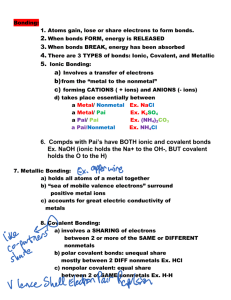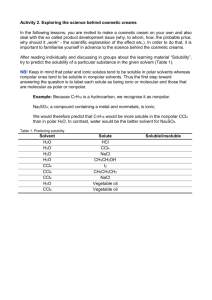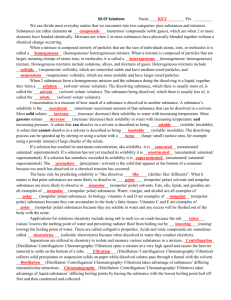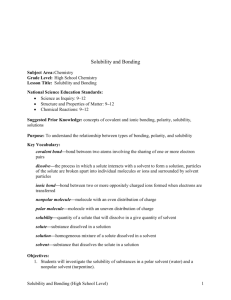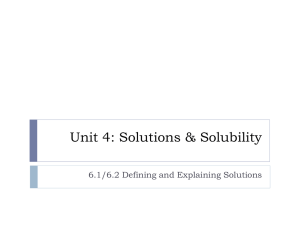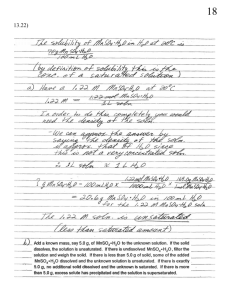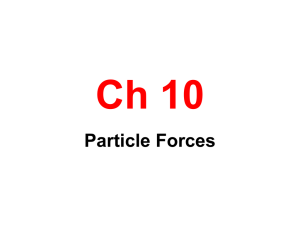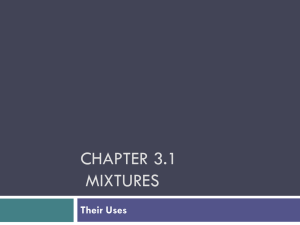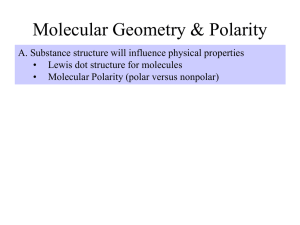Chapter 14: Solutions
advertisement
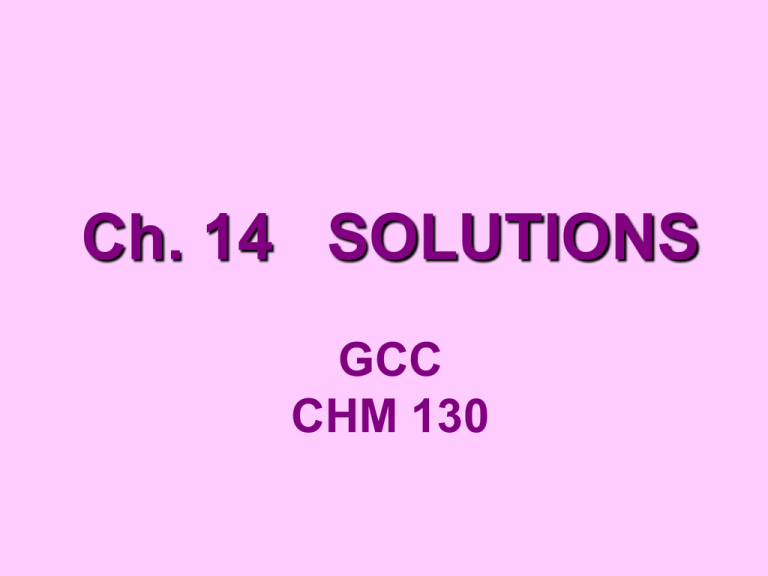
Ch. 14 SOLUTIONS GCC CHM 130 What is a solution? • solution - A solute dissolved in a solvent – solute - chemical there’s less of – solvent - chemical there’s more of • Water is the most common solvent. Physical states of solute and solvent can be solid, liquid or gas Examples: Gas in Liquid Liquid in Liquid Solid in Liquid Gas in Gas Solid in Solid Carbonated Soda Vodka and tonic Salt Water Air (N2 + O2 + trace gas) Steel (Fe + C) 14.1 Gas solubility in liquids 1. Temperature: Solubility of a gas in a decreases liquid ___________as T increases. T increases, gas molecules move faster, escape from surface easier. Think about what happens if you open a can of soda that has been sitting outside for a few hours on a hot Summer day? increases 2) Pressure: Solubility of a gas __________ as the pressure increases. Higher pressure keeps the liquid molecules from escaping into gas by pushing down on them. Another example – as divers descend in the ocean, the solubility of air in blood increases Solid Solubility in liquids • The solubility of a solid will _________ increase as the temperature increases. As T increases, molecules move faster and pull apart the ions in an ionic solid, so it dissolves faster as well. The solubility of a solid is not affected by pressure, unlike a gas. 14.2 Liquids in liquids “Like dissolves like” rule Polar solutes dissolve in polar solvents Nonpolar dissolves in nonpolar Nonpolar and polar don’t mix When two liquids mix we call them miscible, if they don’t mix they are immiscible 14.3 Solids in liquids “Like dissolves like” rule Polar solutes dissolve in polar solvents Nonpolar dissolves in nonpolar Nonpolar and polar don’t mix If a solid dissolves it is soluble, if not it is insoluble Note - Solubility rules are for ionic solid solutes in water solvent!!! But not all solvents are water…. Will these solutes dissolve in these solvents? Solvent Solute HCl Solute I2 Solute PCl3 Solute CH4 NH3 Y No Y No C12H26 No Y No Y Br2 No Y No Y Miscible, immiscible, soluble or insoluble Solutes i polar liquid nonpolar liquid polar solvent miscible immiscible immiscible miscible polar solid soluble nonpolar solid insoluble ionic solid nonpolar solvent Check Solubility Rules! insoluble soluble insoluble Which is soluble in oil? I2, P4, grease Which is miscible in oil? CCl4 (Hint – is oil polar or nonpolar?) nonpolar I2(s) ionic KCl (s) nonpolar P4 (s) grease(s) nonpolar polar HBr (l) CCl4 (l) nonpolar Nonpolar chemicals mix with oil – “like dissolves like” 14.4 THE DISSOLVING PROCESS • solvent molecules pull the solute molecules from each other if the solutesolvent attraction is greater than the solute-solute attraction • http://www.northland.cc.mn.us/biology/Biology1111/animations/dissolve.html • http://www.mhhe.com/physsci/chemistry/essentialchemistry/flash/molvie1.swf • http://www.chem.iastate.edu/group/Greenbowe/sections/projectfolder/flashfiles/thermochem/solutionSalt.html 14.8 Concentration • concentrated solution – lots of solute • dilute solution – little solute • If your drink is “strong,” it is concentrated. If your coffee is “weak,” it is dilute. Concentration • The amount of solute in solvent is the concentration. • Units for concentration: - Mass Percent (%) - Molarity (M) 14.8 Mass % x 100 gramssolute = gramssolute gramssolvent Ex: Calc. the mass % for 15.0 grams of potassium nitrate being dissolved in 135 grams of water. Mass % = (15.0g / 15.0+135g) x 100 = 10.0% Ex: How many grams of water are needed to make a 5.00% saline solution with 10.0 grams of salt? First set up: 5.00% = 10.0 (100) 10.0 x 5.00 (10.0 + x) = 10.0 (100) 5.00 (10.0 + x) = 1000 10.0 + x = 1000 / 5.00 10.0 + x = 200 X = 1.90x102 grams check: 5.00 = (10/200) (100) Yes 14.9 Molarity • MOLARITY (M) = moles per liter M = moles solute = mol liters of solution L Ex: Calculate the molarity if 9.99 grams of potassium bromide is dissolved in 2.50 liters of water. 9.99 g KBr ( mol / 119.00 g) = 0.08395 mol M = 0.08395 mol / 2.50 L = 0.0336 mol/L Do the questions in the online notes and worksheet !!! Self Test • Page 410 • Try 1-4, 8-9, 13-15 • Answers in Appendix J

